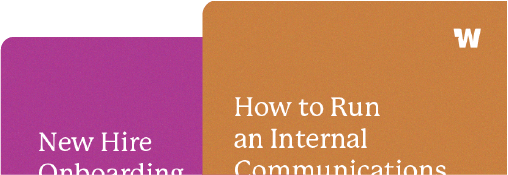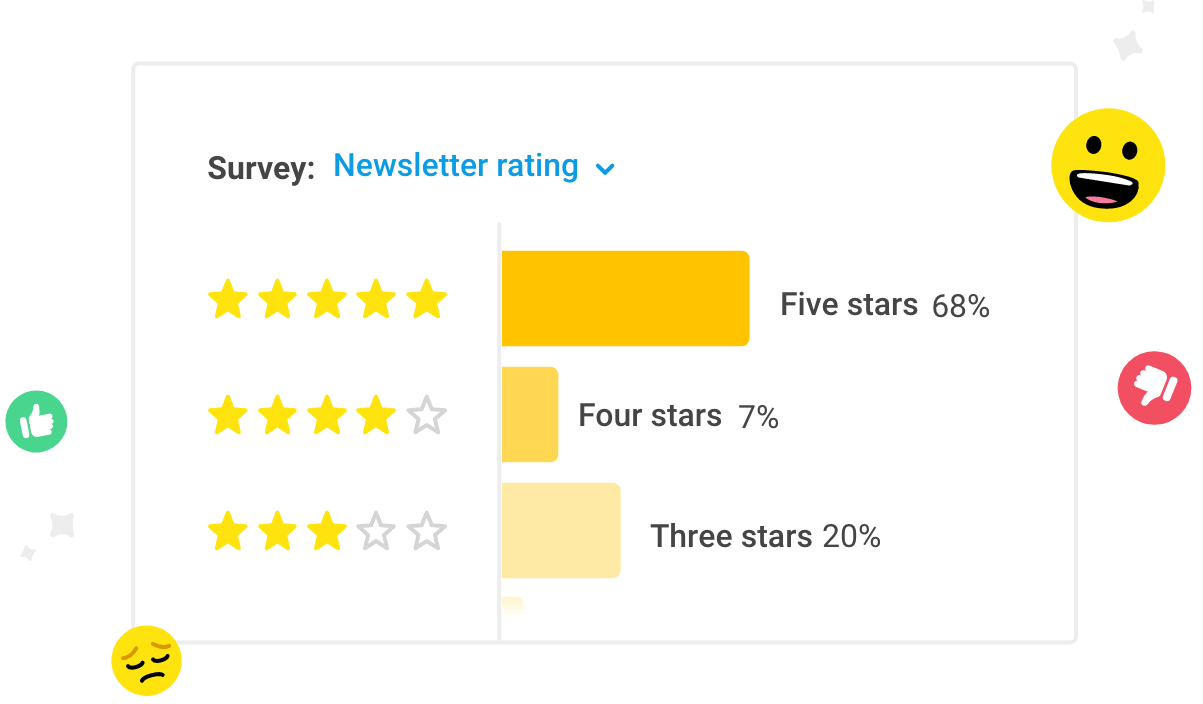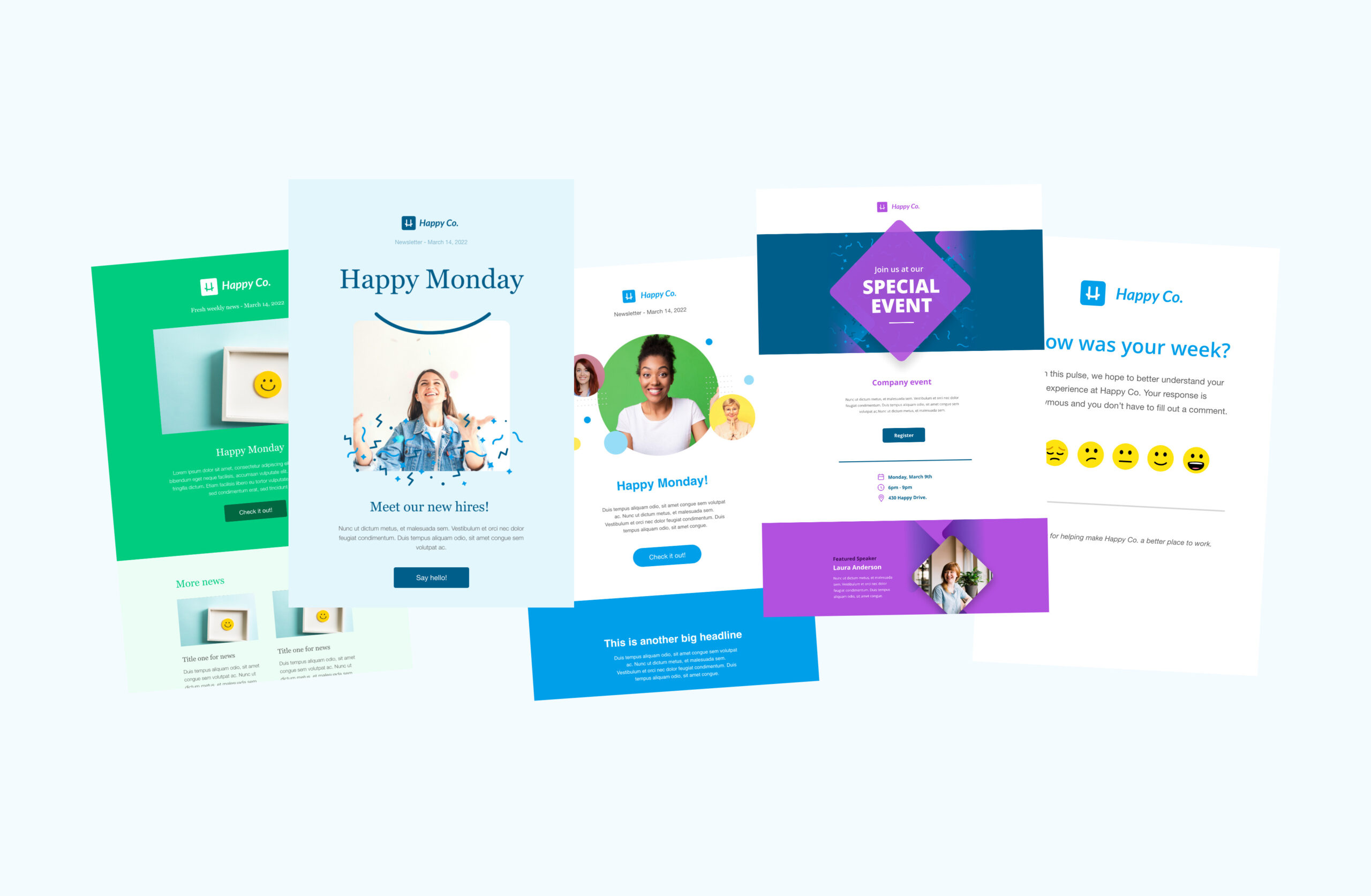How to perfect your internal communications plan
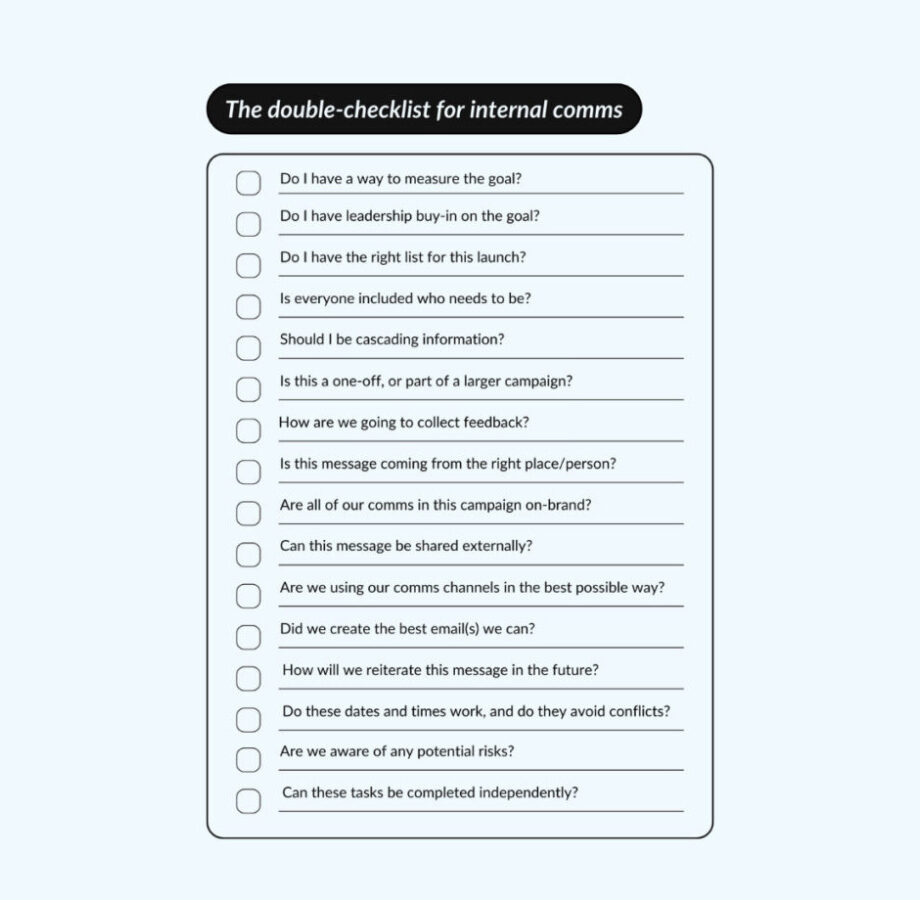
You’ve got your internal comms plan filled out and ready to roll, but…what if you’ve overlooked something?
We all get that nagging feeling every now and then, but we’re here to walk you through a quick set of questions that can ensure you’ve got every base covered for your next internal launch. This list has been curated after launching countless internal communications initiatives, so you can launch your latest campaign with complete confidence!
Is your internal comms plan complete?
Your internal comms plan should be a strategy outline of an internal campaign that will be executed over some time frame with a clear goal and measurable results.
They typically look a little something like this example:
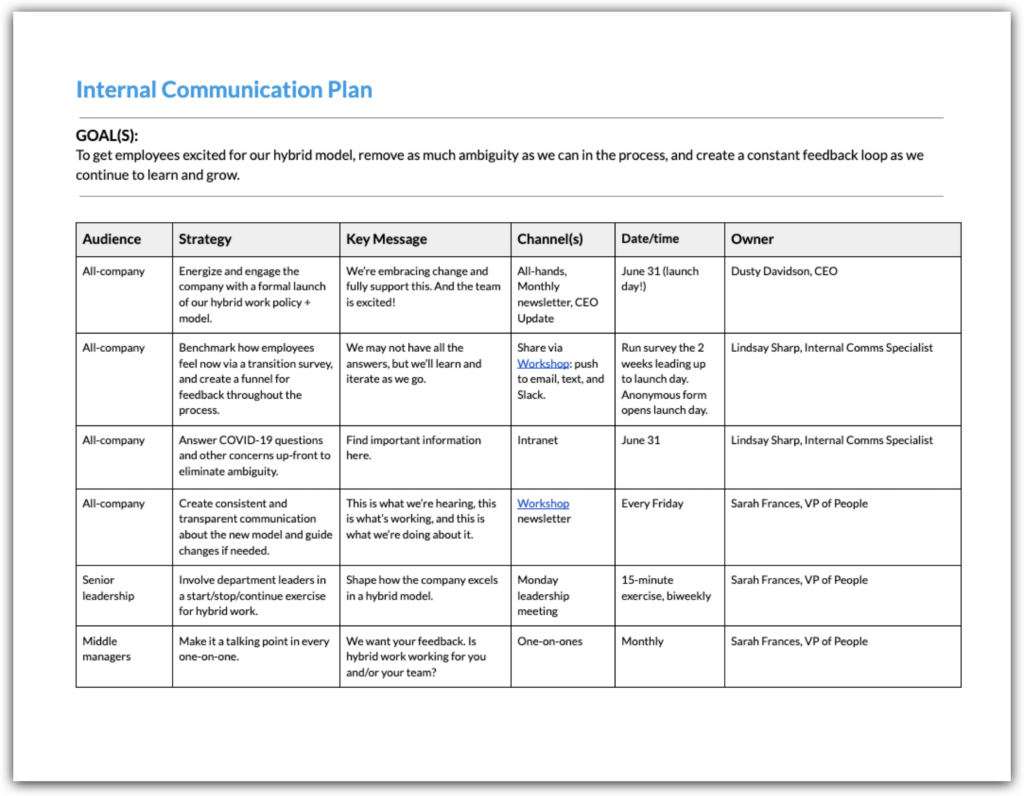
You can download this internal comms plan template and fill it out with your own information here!
It may seem like a lot, but we truly believe that intentionality is the most important part of any successful internal communications strategy. And you may not need this robust plan/outline for every single initiative, but we often find that if there are a lot of moving parts, or if you’re planning on executing this campaign over a long time frame or multiple times, it’s definitely worth putting in the extra effort.
In filling out your plan, be sure that you’re considering the past, present, and the future of the initiative:
- The past: What have you learned from previous launches that you can incorporate here? Have you launched anything in the past you can compare it to? Are there lessons to be learned from other companies who have done something similar?
- The present: What channels are your employees using to communicate today? How does this align with the company’s mission, vision, values, and current goals? Is everyone on the same page right now, or is there work to be done to build buy-in across teams or departments?
- The future: How will you collect feedback? How will you follow up on this initiative? Is this a one-off, or part of a larger project? Is it experimental, or core to your strategy?
Once you feel really great about the document you have in place, now’s the time to fine-tune it a bit. We consider this all part of a kind of “double-checklist” for internal communications, and it’s important to do a final pass just to make sure you aren’t missing something that could hinder the success of your campaign. Plus, we often find that these small tweaks make your efforts even more successful! We’ll go through each part of the internal comms plan template in more detail.
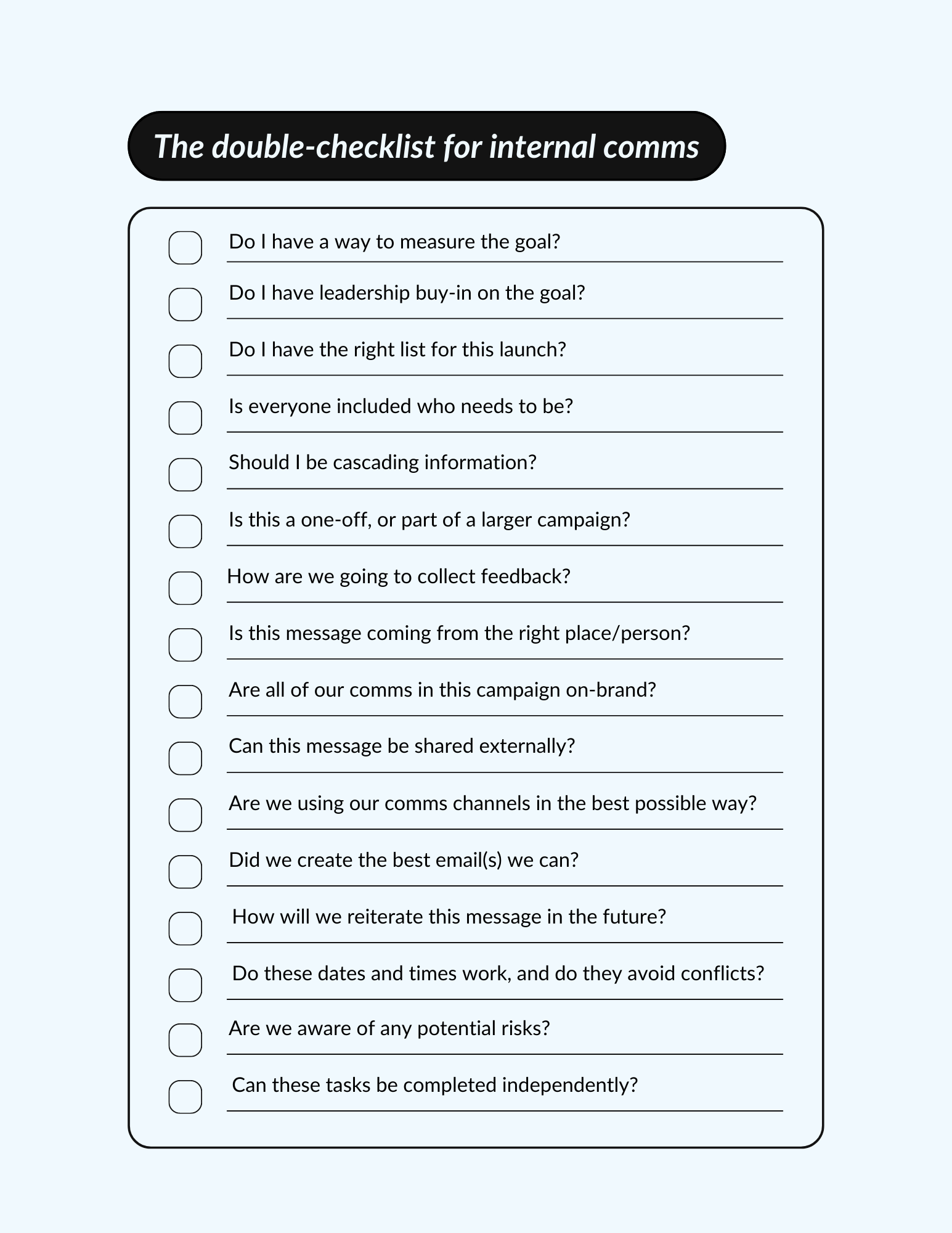
PERFECTING THE GOAL
1.) Do I have a way to measure the goal?
You’d be surprised how often someone writes a goal that is really abstract or impossible to measure. That doesn’t mean you have to have some kind of complicated data set up; you might want qualitative feedback (like comments or survey results), or you might want quantitative measures (like clicks, read time, or replies).
Here’s how we might dig into this in our example above:
We want to achieve X as measured by Y.
We want to get employees excited about our hybrid work model, as measured by an 80% positive response on our return-to-work survey.
We want to create a constant feedback loop, as measured by responses to our weekly all-staff email.
We always recommend using some kind of past data for comparison, and using your own data for benchmarking success (not metrics that you Google’d)! All to often we see a customer trying to reach an “industry standard” metric that they’ve never reached in the past. Focus on making small improvements to your existing efforts, and you’ll get there!
There are two measurements that are really nice to have when determining the success of your internal comms initiatives: the ability to break down your email data by department, role, and location, and the ability to pull the success of a series of emails (we call them campaigns) over time. Both of these analytics are available in Workshop, so you can segment engagement with your emails by audience and/or by topic.
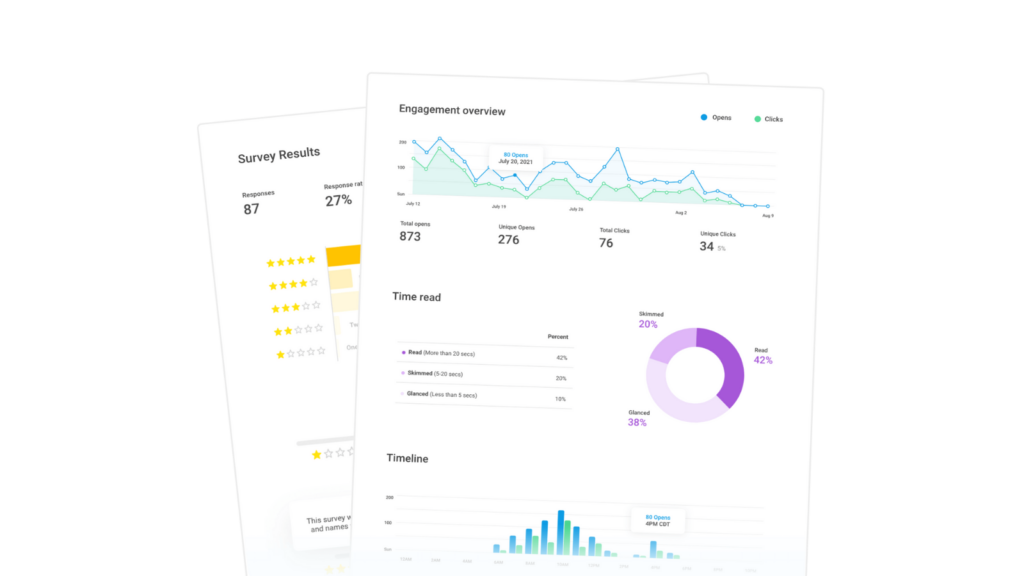
2.) Do I have leadership buy-in on the goal?
You want to make sure everyone is bought into the plan before putting in all the effort to roll it out. Someone from your C-suite likely needs to be actively engaged in the creation of your internal comms plan; get them involved where it makes sense, and know how they prefer to be involved.
Be really specific about their role, provide a timeline, and make it easy for them to be bought into it and to participate. It’s even better if you can map your plan to the priorities the company is most focused on, and connect it your your company’s mission, vision, values, or yearly/quarterly goals.
PERFECTING THE AUDIENCE
1.) Do I have the right list for this launch?
All too often, an internal comms email is blasted out to the entire staff, when a more refined approach would be much more effective. Segment your message (often, at least by location or team); studies show that proper email segmentation can increase your open rates by 203%. Use the right tool to sync with your employee/HR data, create automatic lists of departments and locations, and keep those lists up-to-date.
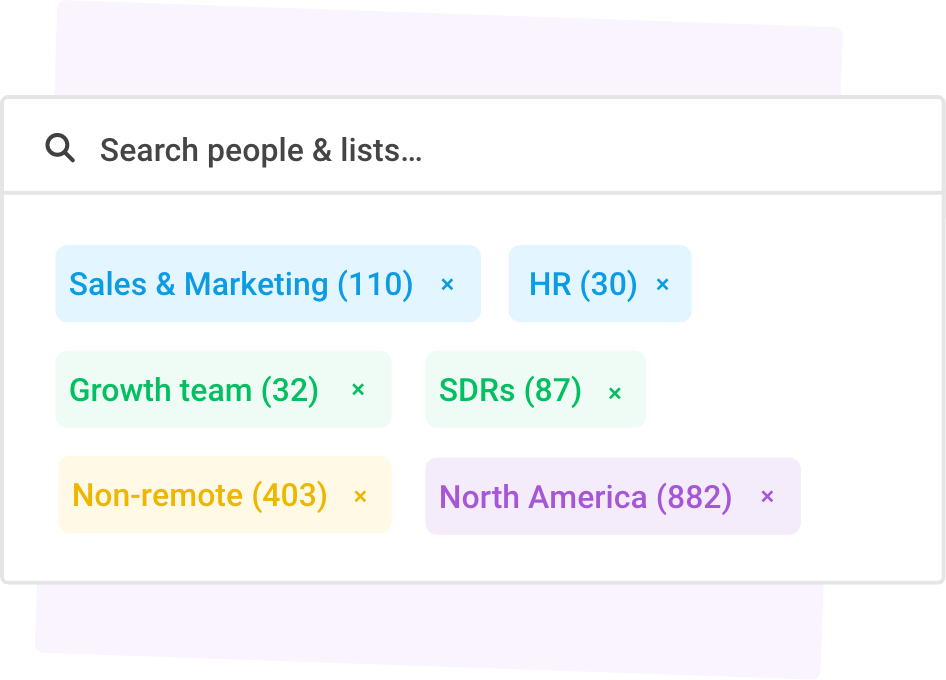
2.) Is everyone included who needs to be?
There are a handful of audiences that are often overlooked when sending out internal communications:
- Employees without corporate email addresses
- New hires
- Employees on vacation/leave
Be sure these individuals are covered or you have a plan in place to reach them for mission-critical information.
3.) Are there any special considerations here that I might be overlooking?
There are quite a few groups that we find are either overlooked, ignored, or improperly leveraged when launching an internal comms plan:
- Department heads/middle managers: Utilize this group to cascade information whenever possible and create strategies to deliver your message in department- or team-specific ways.
- Brand ambassadors: There’s almost always a group of employees that champion the company internally; you can find strategic ways to get them more involved in your internal comms plan and boost the success of your launch.
- Unengaged employees: If you have a group of individuals who are “checked out,” consider how this campaign can reach them or reignite their interest.
- Underrepresented groups: Always consider diversity, equity, and inclusion when putting together an internal communications campaign. Be sure that you have representation when putting the plan together in the first place, and/or have a variety of individuals from different backgrounds review the plan before launching it.
4.) Should I be cascading information?
It can suck when managers find out information (good or bad) at the same time as everyone else. Maybe the team is bringing on a new giant client that will significantly impact their workload, announcing a really meaningful departure/hire, etc. You should always review your plan and make sure that the timeline you’ve outlined ensures that the right people find out at the right time; no one wants to read a tweet about it before hearing from the company themselves. And for really big changes, consider time zones and how fast information can travel!
PERFECTING THE STRATEGY
1.) Is this a one-off, or part of a larger campaign?
This may effect the entire process, including who needs to be involved and especially how you want to measure the impact. Some communications projects are just one-and-done line items (you need to get it out, once, and fast) and others may be initiatives that occur year in and year out, or on a consistent cadence, that you may want to measure over time (like monthly newsletters or open enrollment). Taking the time to consider this question will help you gauge the priority of the effort, and how much time and energy is appropriate to spend on it!
2.) How are we going to collect feedback?
This gets overlooked in the majority of internal communications campaigns, but you should always incorporate it as a part of your strategy, if you can. A few ideas:
- Consider adding a pulse survey before, during, or after the campaign
- “Focus groups” can be helpful for crafting messaging for large-scale changes or campaigns
- Have a way to deliver that feedback succinctly to leadership/stakeholders
3.) Is this message coming from the right place/person?
In almost all cases, your message may be more effective coming from a specific team or individual, instead of simply “from the comms desk.” For example, if you’re launching a rebrand of the company, the message could be delivered by your CMO or creative director, rather than comms. Or, if you’re introducing a CEO, you will want to make sure that part of the strategy involves comms from that CEO. It doesn’t mean that comms isn’t involved in the crafting, sending, or delivering the message…simply that you’re going to boost performance by ensuring that it comes from the most relevant source.
Plus, it also helps to show that there’s a diversity of voices within your organization, and helps to humanize the campaign!
PERFECTING THE MESSAGING
1.) Is this internal comms plan on brand?
Double-check that your content, your creative, and your strategy all reinforce the company’s mission, vision, and values. You may also want to work with the marketing/creative team closely to deliver your message, and to ensure that you have a consistent voice, tone, look, and feel across your internal and external materials. When in doubt: just be human, and/or use photos of employees as your creative assets.
2.) Can this message be shared externally?
Be clear about what employees can and cannot share externally, and be cognizant that it might get shared externally even without your approval. In many cases, encouraging sharing externally can really elevate the success of the campaign and build brand ambassadors. If you want to encourage sharing, consider providing some boilerplate messaging, graphics, and examples to make it easier for your employees to post it on their own social media profiles, include it in emails, and more.
PERFECTING THE CHANNELS
1.) Are we using our comms channels in the best possible way?
Here’s a quick way to think about communications channels, for most companies:
- Email = best primary method of internal communications & a great anchor for a campaign
- Text = great for frontline/deskless employees
- Intranet = good for archiving information, asynchronous
- Slack/Teams = great for the mobile-first generation
You may also want to consider if there are any new channels you should be leveraging. And, regardless of if you have an intranet or not…make sure there is a place where the information can be accessed in a more evergreen or permanent way, if needed.
2.) Did we create the best email(s) we can?
If you’re anchoring your communications plan with email, please do not send out a lackluster, text-based message that can be totally disregarded in your employees’ inboxes!
Here are a few things we recommend to customers who are looking to create the perfect email template:
- Start with your biggest announcement
- Consider a section of “quick hits” or little bits of info
- Make it visually interesting; break up content into blocks
- Make sure it’s mobile-friendly!
- Include ~3 large images/photos
These suggestions are well-suited for a newsletter or a campaign that needs to include a lot of information (like a product launch, or an internal event announcement). For more mission-critical information, you may want to make the email shorter, with one very strong call-to-action.
3.) How will this message be reiterated in the future?
It’s pretty rare that an internal communications plan needs to be executed once and then never looked at or used again. As such, we recommend making content distribution a cornerstone of your strategy. Be sure you’re distributing key information and/or links to the email to other comms channels (we have a push feature built into Workshop just for this).
You’ll also likely want to include a plan to re-send emails and important information to the employees who didn’t engage with it the first time. Remember, it’s VERY rare that any one singular channel will reach every single one of your employees; by creating a plan to reiterate the message on multiple channels, you’re ensuring you do get that 100% coverage with your audience.
PERFECTING THE TIMING
1.) Have you double-checked your dates and times?
Really look at the rollout of information and make sure your timeline is reflected accordingly.
There are two major considerations that we often see overlooked: holidays/observances, and time zones. Make sure you’re avoiding any conflicts with national holidays, observances, or important cultural events. You’ll also likely want to send your comms based on time zone, so that your European offices aren’t receiving information in the really early hours of the morning or late into the night, for example.
2.) Are you aware of any potential risks to the timeline?
Think about a worst-case scenario where you need to pull the plug or edit the entire thing. Do you have a quick plan in place for you to contact all those involved? If emails are scheduled, are you able to pause them immediately? Is there anything specific that could cause the entire plan to shift (say, if there’s a leak to the press, or a national incident)? If you can identify any specific or generalized risks to the project, you may need to develop a separate crisis communications plan and/or a couple of holding statements, just in case.
PERFECTING THE TASK/OWNER
1.) Can your task owner complete the task independently?
When assigning out different parts of your communications plan, try to identify owners who either supervise the contributors responsible, or those who can get it done independently. For example, we often see email projects get assigned to internal communications teams, but they have a heavy reliance on IT in order to get the list necessary to complete the project. Write those out as separate tasks and line items, just to make sure there aren’t any invisible dependencies that’ll trip the entire project up.
Once you’ve gone through this “double-checklist” with a few different internal comms plans, it’ll become second nature to you to look for a few of these finer details!
This article is the written version of a digital webinar that we co-hosted with Ragan. You can see the full recording of the webinar here!
